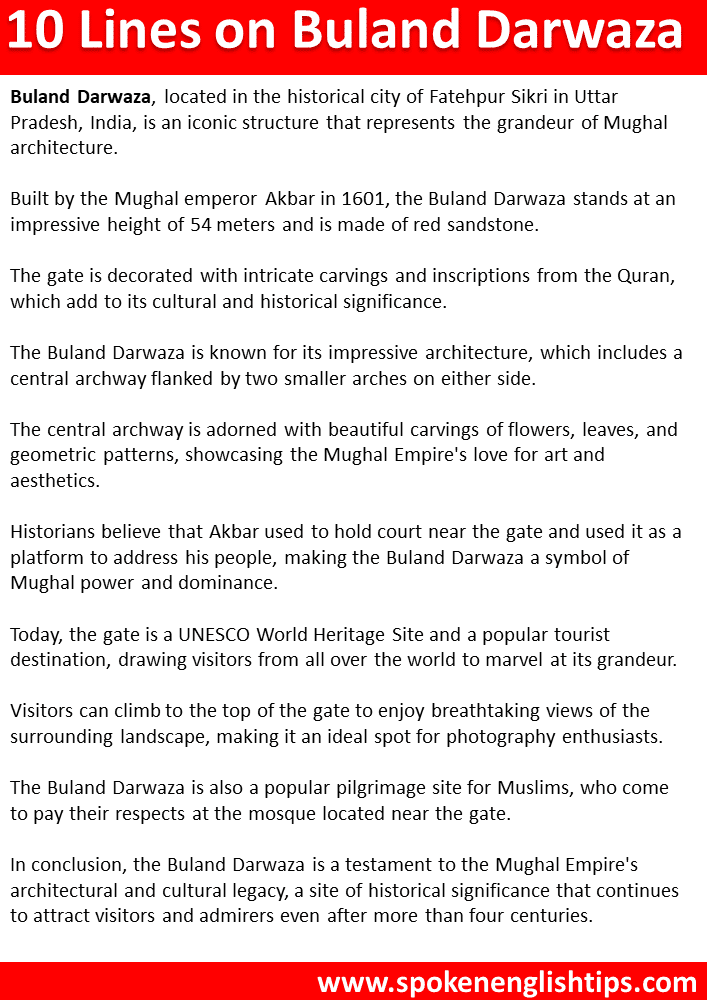10 lines on buland darwaza: Buland Darwaza, also known as the “Gate of Magnificence,” is an imposing gateway located in Fatehpur Sikri, a city in the northern Indian state of Uttar Pradesh. It was built by the Mughal Emperor Akbar in 1601 to commemorate his victory over the Kingdom of Gujarat.
The Buland Darwaza is made of red sandstone and stands at an impressive height of 54 meters. It is adorned with intricate carvings and inscriptions from the Quran, which adds to its grandeur and cultural significance.
The gate is known for its impressive architecture, which includes a central archway that is flanked by two smaller arches on either side. The central archway is adorned with intricate carvings of flowers, leaves, and geometric patterns.
Buland Darwaza is also famous for its role in the history of India. It is believed that Akbar used to hold court near the gate and used it as a platform to address his people. It is also said that the gate served as a symbol of the Mughal Empire’s power and dominance.
Today, the Buland Darwaza is a popular tourist attraction and a UNESCO World Heritage Site. Visitors can climb to the top of the gate to enjoy stunning views of the surrounding area.
Overall, the Buland Darwaza is an architectural marvel that represents the grandeur and cultural richness of India’s past. It is a must-visit destination for anyone interested in history, architecture, and culture.

10 lines on Buland Darwaza
Buland Darwaza, located in the historical city of Fatehpur Sikri in Uttar Pradesh, India, is an iconic structure that represents the grandeur of the Mughal architecture.
Built by the Mughal emperor Akbar in 1601, the Buland Darwaza stands at an impressive height of 54 meters and is made of red sandstone.
The gate is decorated with intricate carvings and inscriptions from the Quran, which add to its cultural and historical significance.
The Buland Darwaza is known for its impressive architecture, which includes a central archway flanked by two smaller arches on either side.
The central archway is adorned with beautiful carvings of flowers, leaves, and geometric patterns, showcasing the Mughal Empire’s love for art and aesthetics.
Historians believe that Akbar used to hold court near the gate and used it as a platform to address his people, making the Buland Darwaza a symbol of Mughal power and dominance.
Today, the gate is a UNESCO World Heritage Site and a popular tourist destination, drawing visitors from all over the world to marvel at its grandeur.
Visitors can climb to the top of the gate to enjoy breathtaking views of the surrounding landscape, making it an ideal spot for photography enthusiasts.
The Buland Darwaza is also a popular pilgrimage site for Muslims, who come to pay their respects at the mosque located near the gate.
In conclusion, the Buland Darwaza is a testament to the Mughal Empire’s architectural and cultural legacy, a site of historical significance that continues to attract visitors and admirers even after more than four centuries.
See Also:
- 10 Lines Essays for Kids and Students
- 10 Lines Essays for Kids and Students (K3, K10, K12 and Competitive Exams)
- 10 lines on independence day – Short Essay